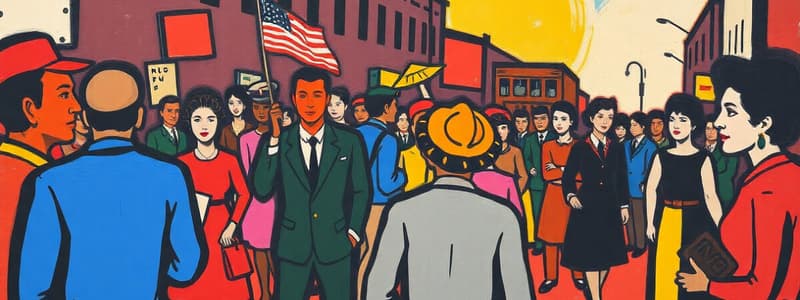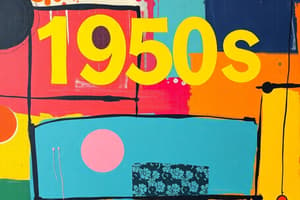Podcast
Questions and Answers
What was the primary purpose of the GI Bill?
What was the primary purpose of the GI Bill?
- To assist World War II veterans in reintegrating into civilian life. (correct)
- To provide financial support for new businesses.
- To fund the construction of veterans' hospitals.
- To promote military enlistment among young Americans.
How did redlining impact African American communities?
How did redlining impact African American communities?
- It contributed to racial segregation and economic disparities. (correct)
- It led to increased opportunities for homeownership.
- It improved access to insurance and mortgages.
- It enhanced economic growth in minority areas.
What did conformity in the 1950s primarily emphasize?
What did conformity in the 1950s primarily emphasize?
- Deviating from societal norms.
- Exploration of new art forms.
- Political activism and civil rights.
- Adherence to traditional values and suburban lifestyles. (correct)
What was a significant feature of Levittowns in the post-World War II era?
What was a significant feature of Levittowns in the post-World War II era?
What was a key characteristic of beatniks during the 1950s?
What was a key characteristic of beatniks during the 1950s?
How did the 1950s impact women's roles in society?
How did the 1950s impact women's roles in society?
What was one consequence of the rise of conformity in 1950s American culture?
What was one consequence of the rise of conformity in 1950s American culture?
Which of the following best describes non-conformity in the 1950s?
Which of the following best describes non-conformity in the 1950s?
What cultural trend characterized the 1950s in America?
What cultural trend characterized the 1950s in America?
What was a primary influence of the beatnik movement on future cultural developments?
What was a primary influence of the beatnik movement on future cultural developments?
What was one consequence of the post-war economic boom in the 1950s?
What was one consequence of the post-war economic boom in the 1950s?
Which major social movement began to gain momentum in the 1950s despite economic prosperity?
Which major social movement began to gain momentum in the 1950s despite economic prosperity?
What was a significant outcome of the GI Bill's implementation?
What was a significant outcome of the GI Bill's implementation?
What genre of music did Elvis Presley help popularize in the 1950s?
What genre of music did Elvis Presley help popularize in the 1950s?
Which demographic did Elvis Presley primarily bring rock 'n' roll to?
Which demographic did Elvis Presley primarily bring rock 'n' roll to?
What criticism was leveled against Elvis for his music?
What criticism was leveled against Elvis for his music?
What role did television play in the 1950s American culture?
What role did television play in the 1950s American culture?
How did car culture impact American society in the 1950s?
How did car culture impact American society in the 1950s?
What was one of the consequences of Elvis's success in popularizing rock 'n' roll?
What was one of the consequences of Elvis's success in popularizing rock 'n' roll?
What societal change was significantly influenced by the rise of car culture in the 1950s?
What societal change was significantly influenced by the rise of car culture in the 1950s?
What was one of the defining characteristics of television during the 1950s?
What was one of the defining characteristics of television during the 1950s?
Flashcards
GI Bill Definition
GI Bill Definition
The Servicemen's Readjustment Act, aiding WWII veterans with home loans, education, and unemployment benefits.
Redlining Definition
Redlining Definition
Financial discrimination against residents in certain areas based on race/ethnicity.
Conformity in 1950s
Conformity in 1950s
American culture's expectation of following traditional values and suburban lifestyles.
Non-conformity Definition
Non-conformity Definition
Signup and view all the flashcards
Beatniks Definition
Beatniks Definition
Signup and view all the flashcards
GI Bill Impact
GI Bill Impact
Signup and view all the flashcards
Redlining Impact
Redlining Impact
Signup and view all the flashcards
Non-conformity Impact
Non-conformity Impact
Signup and view all the flashcards
Levittowns
Levittowns
Signup and view all the flashcards
Post-War Economic Boom
Post-War Economic Boom
Signup and view all the flashcards
Civil Rights Movement
Civil Rights Movement
Signup and view all the flashcards
Youth Culture
Youth Culture
Signup and view all the flashcards
Women's Roles in the 1950s
Women's Roles in the 1950s
Signup and view all the flashcards
Rock 'n' Roll
Rock 'n' Roll
Signup and view all the flashcards
Elvis Presley - Rock 'n' Roll King?
Elvis Presley - Rock 'n' Roll King?
Signup and view all the flashcards
Elvis's Musical Legacy
Elvis's Musical Legacy
Signup and view all the flashcards
Television's Rise
Television's Rise
Signup and view all the flashcards
Television's Impact
Television's Impact
Signup and view all the flashcards
Car Culture's Boom
Car Culture's Boom
Signup and view all the flashcards
Impact of Car Culture
Impact of Car Culture
Signup and view all the flashcards
Car Culture and Society
Car Culture and Society
Signup and view all the flashcards
Study Notes
GI Bill
- Definition: The Servicemen's Readjustment Act of 1944, providing benefits for World War II veterans (low-cost mortgages, education loans, unemployment compensation).
- Importance: Helped veterans transition to civilian life, contributing to the rise of the middle class and promoting homeownership and education.
Redlining
- Definition: Discriminatory practice where banks, insurers, and financial institutions refused or limited services based on racial or ethnic composition, often marking minority neighborhoods in red on maps.
- Impact: Contributed to racial segregation, economic disparities, and limited opportunities for homeownership and investment in African American communities. It fostered long-term economic inequality.
Conformity and Non-Conformity
Conformity
- Definition: Societal expectation for individuals to adhere to traditional values, norms, and lifestyles, often centered around suburban life, family, and consumerism.
- Impact: Conformity was a key part of American culture in the 1950s, with individuals and families striving for a 'perfect' suburban lifestyle.
Non-Conformity
- Definition: The rejection or deviation from traditional norms and expectations. This was seen in counter-cultural groups like beatniks and the early civil rights movement during the 1950s.
- Impact: Non-conformists questioned societal values, materialism, and the "American Dream" concept.
Beatniks
- Definition: Group of young people in the 1950s rejecting mainstream culture, exploring self-expression through literature, art, and music.
- Impact: Paved the way for the 1960s counter-culture movement, influencing attitudes toward freedom, individualism, and rebellion.
Rock 'n' Roll and Elvis
- Definition: A genre of popular music combining rhythm and blues, country, and gospel music—Elvis Presley symbolized rock 'n' roll.
- Impact: Revolutionized the music industry and brought rock ‘n’ roll to mainstream audiences, especially white teenagers. He blurred racial divides by popularizing African-American inspired music.
Controversy Surrounding Elvis's Appropriation of Black Music
- Definition: Elvis Presley was criticized for "appropriating" African American music (particularly rhythm and blues) without giving credit to the original artists.
- Impact: While Elvis's music made Black music more accessible to white audiences, it also highlighted racial inequalities, with Black musicians often not receiving the same recognition or opportunities.
Rise and Impact of Television
- Definition: Television became a dominant form of entertainment and communication in the 1950s. Popular shows like I Love Lucy and The Ed Sullivan Show influenced public attitudes.
- Impact: Shaped American culture, provided shared national experiences, and influenced consumer behavior, political views, social values.
Impact of Car Culture
- Definition: Automobiles became a symbol of freedom, mobility, and independence in the 1950s which influenced suburban expansion, consumerism, and highway development.
- Impact: Shaped social behavior, contributing to the rise of drive-in movies and fast food restaurants.
Levittowns
- Definition: Large suburban housing developments, mass-produced and affordable-homes, popular in post-World War II suburbs.
- Impact: Exemplified the postwar suburban boom and the "American Dream" of homeownership. However, these developments were also criticized for racial segregation and encouraging conformity.
Role of Women in the 1950s
- Definition: Women were expected to fulfill traditional roles as wives and mothers, embracing domesticity and family life during the 1950s.
- Impact: Laid the foundation for the feminist movements of the 1960s and 1970s.
Key Themes and Concepts
- Post-War Economic Boom: Prosperity, suburban growth, and mass consumerism.
- Civil Rights: Persistent racial inequalities, early beginnings of the Civil Rights Movement, and challenges to racial injustice.
- Youth Culture: The emergence of distinctive youth culture, marked by music, fashion, and rebellion against the previous generation's values.
Studying That Suits You
Use AI to generate personalized quizzes and flashcards to suit your learning preferences.




